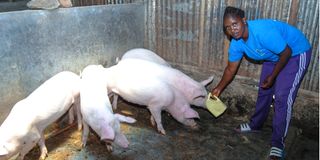Premium
Vet on call: Rats, the unsuspected enemy of livestock

Damaris Gatwiri feeds her six-month-old pigs at Green estate in Elburgon, Nakuru County.
What you need to know:
- One of the uniqueness of biological assets is that they can wither overnight, lose great value or just evaporate in death.
- Fortunately, scientific findings so far have not shown infection of livestock with Covid-19. We hope the situation remains so.
- A farm disease investigation is never complete without the doctor pinpointing the most probable source of the infection.
Animals, plants and micro-organisms can largely be classified as biological wealth.
Owing to their diversity and being part of our socio-economic activities, we often fail to appreciate the ever-present risks associated with wealth creation pegged on biological assets.
One of the uniqueness of biological assets is that they can wither overnight, lose great value or just evaporate in death.
They can also get destroyed as part of radical disease control measures meant to safeguard other assets or public health.
The trickiest thing with biological assets is that they are prone to serious interference by environmental factors including weather, but the most critical of all is the interaction between disease-causing organisms known as pathogens and biological assets.
If the ongoing Covid-19 pandemic had selected livestock as its preferred host, we could have wiped out most of the animals as part of disease control intervention and protection of human beings. It has been done before with diseases like foot and mouth and African swine fever.
Fortunately, scientific findings so far have not shown infection of livestock with Covid-19. We hope the situation remains so.
Signs of disease
Another tricky thing is that some deadly diseases may remain in the wild or in wild animals, only to cause severe problems to livestock when an opportunity arises. Early this week, I had an interesting case with pigs in Kiambu.
The farmer reported she had lost a baconer pig overnight. The pig had apparently not shown any signs of disease the previous day.
According to the workers, the animal had eaten well the previous evening but they found it dead in the morning. All other pigs in the pen looked healthy.
Another pig in another pen had developed severe continuous frank blood diarrhoea. It had been apparently healthy the previous evening.
The farmer said she thought it was swine dysentery from her consultation with “Dr Google”. I told her may be not because all the other pigs were healthy but we agreed I visit the farm.
I advised her to isolate the pig and disinfect the pen immediately for the benefit of the other animals in the group.
I examined the pig on the farm and told the farmer I had never seen such a site before. The pig was just passing out frank blood.
The temperature was below normal and the ear veins could not engorge even after rubbing them with the chemical xylene.
Source of infection
This meant there was a heavy load of infectious agents and toxins in the pig’s bloodstream.
I agreed with the farmer the pig was most likely suffering from swine dysentery.
I gave the recommended treatment of combination antibiotics by injection into the muscles and giving by mouth.
I instructed the farm manager, who is a veterinary para-professional, to inject one of the antibiotics for another two consecutive days.
He would also give a drug combination powder in water for five days. The disease is difficult to treat.
I later did a post-mortem examination on the dead pig and found bacterial infection of the intestines and the stomach.
The infection had ascended to the lungs and caused severe sudden pneumonia. The lungs were also full of fluid and foam. I diagnosed sudden pneumonia emanating from the gut infection.
I instructed the farm manager to administer the antibiotic powder to the pigs in the two pens the dead and sick pigs were from to prevent infection.
Once I finished the investigation and treatment, I disinfected my gumboots and toured the farm. I noted the farmer had made all the adjustments I had prescribed in my last visit in August.
Now the question was where the infection had come from. A farm disease investigation is never complete without the doctor pinpointing the most probable source of the infection.
Rodent-transmitted disease outbreaks
The suspect disease is mainly spread by rodents. Rats are the usual culprit in most rodent-transmitted disease outbreaks. I enquired about feed storage and the sighting of rats.
The farm manager and three other workers laughed.
“We killed about 100 rats in the feed store last week and many others escaped,” one of the workers said. I proceeded to inspect the containerised feed store and found the door open.
Further, the rats had chewed on the rubber seal of the container door and gained access. They had quietly bred in the feed filled container without notice.
I advised the manager to repair the breached section and always keep the store door shut. From the findings, it is possible for a small fraction of the feed to have been contaminated through rat urine or faeces.
However, I’ll still follow up on this case to confirm if it was really swine dysentery. Should other pigs come down with a similar disease, I will take samples for laboratory testing.





